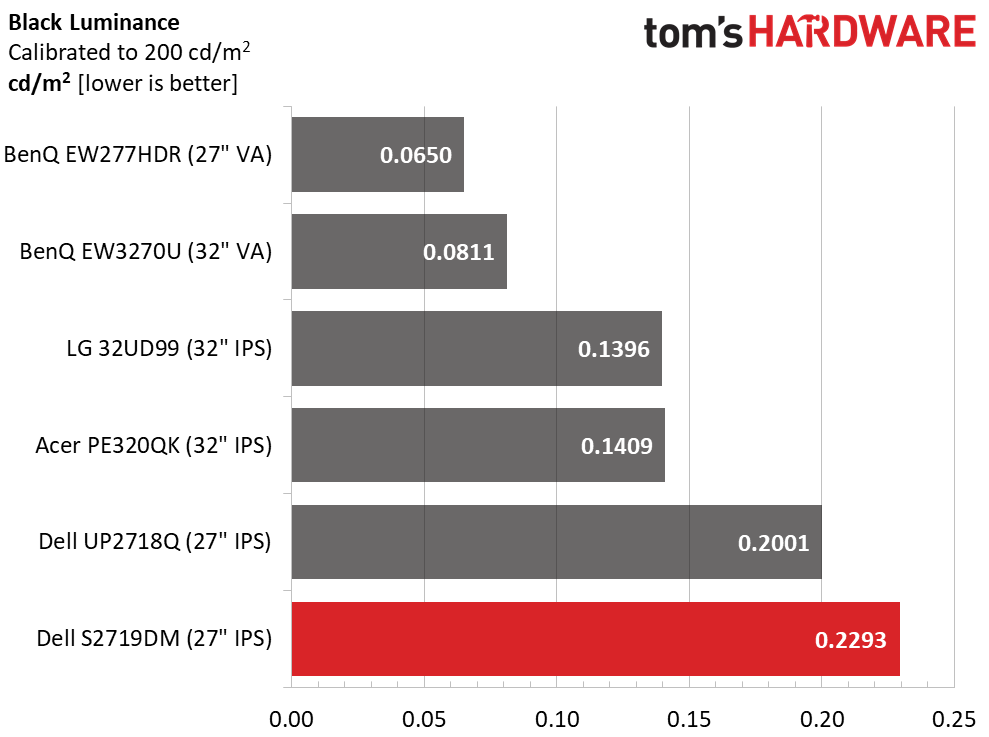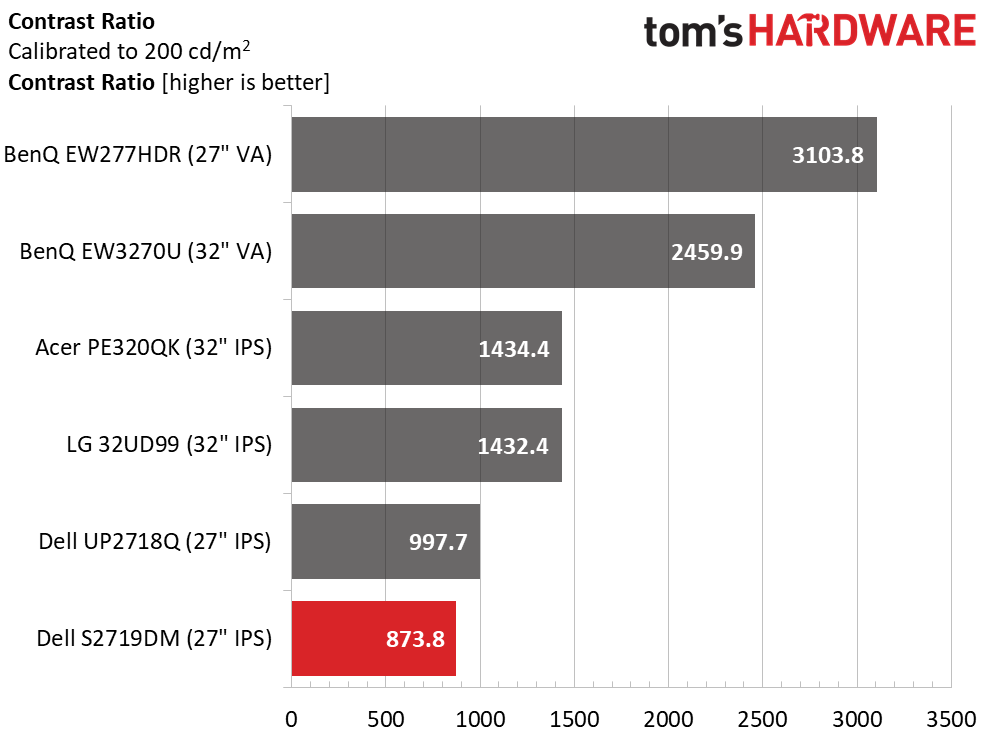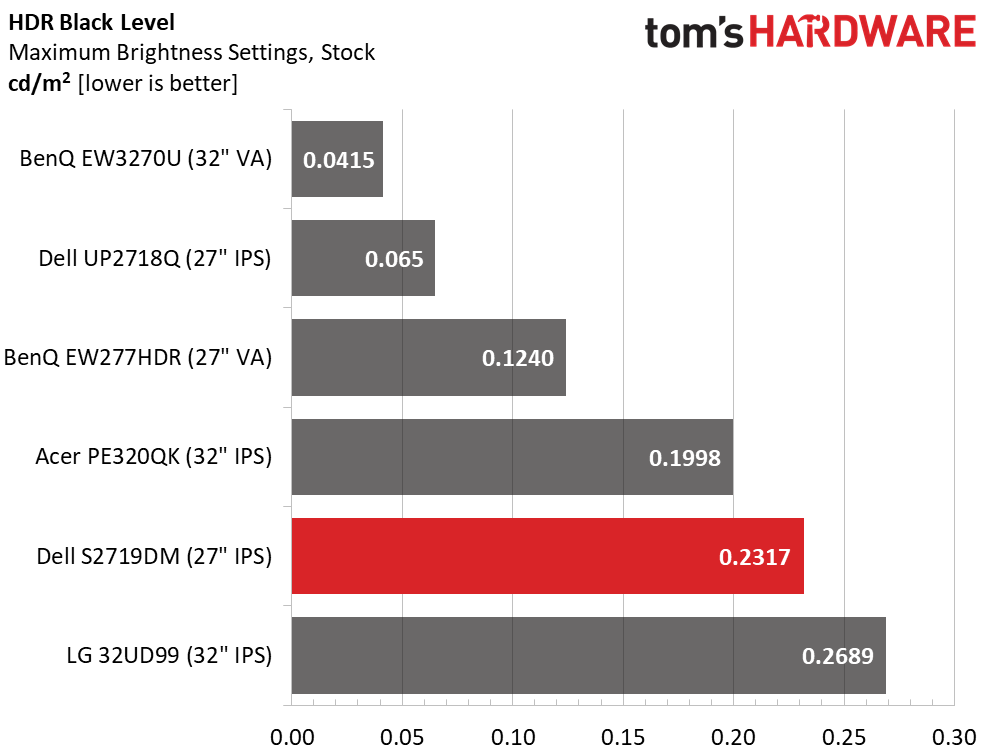Dell S2719DM 27" QHD HDR Monitor Review: Style Meets Performance
Why you can trust Tom's Hardware
Brightness & Contrast
To read about our monitor tests in-depth, check out Display Testing Explained: How We Test Monitors and TVs. Information on Brightness and Contrast testing is on page two.
Uncalibrated – Maximum Backlight Level
To compare the S2719DM's performance, we have LG’s 32UD99, Acer’s PE320QK, BenQ’s EW277HDR and EW3270U and Dell’s UP2718Q, our reference professional screen. The Dell monitor is the only one with a full-array, zone-dimming backlight. All others make do with edge arrays.



The S2719DM has no problem nipping the underside of 400 nits in SDR mode. There aren’t many situations where one would need this much output for SDR material. It doesn’t increase native contrast, and it’s much too bright for any indoor environment. But this sort of output is necessary for the panel to have enough luminance to meet the HDR 400 certification and deliver the required bright highlights for HDR content.
Since we’re dealing with an in-plane switching (IPS) panel, native contrast is average for the category at 1073.2:1 (Acer and LG excel above average here with ratios on either side of 1400:1).
Uncalibrated – Minimum Backlight Level



The backlight’s output covers a broad range - all the way down to 35 nits, which is actually darker than necessary. The downside is that each click of the 100-step slider represents 3-4 nits, which is a bit extreme, making achieving precise output levels difficult. We’d rather see 2.5 nits per click, but this is a minor point. Contrast remains consistent at over 1000:1.
Ultimately, the S2719DM performs as it should here for the price.
After Calibration to 200 nits


We lowered the contrast slider, which reduces SDR dynamic range to 873.8:1. But that adjustment isn’t absolutely necessary. You could leave everything alone, select Standard mode and call it a day.
Get Tom's Hardware's best news and in-depth reviews, straight to your inbox.
The main weakness is black level, which is bit higher than the other panels tested.
HDR Brightness & Contrast



While vertical alignment (VA) panels tested here offer the same peak brightness for HDR as they do for SDR, IPS panels can get quite a bit brighter.
With a well-engineered dynamic contrast algorithm in place, this monitor turns in 2513.6:1 contrast in HDR mode - very respectable.
ANSI Contrast Ratio
Our ANSI test is performed in SDR mode only. The S2719DM remains consistent with its sequential result at 838.5:1. If you opt to leave the contrast slider at its default setting, this result is just over 1000:1.
While not cheap, this monitor performs beyond its cost in this aspect. The panel used here is of very high quality, perhaps better than its price suggests.
MORE: Best Gaming Monitors
MORE: How We Test Monitors
MORE: All Monitor Content
Current page: Brightness & Contrast
Prev Page OSD Setup & Calibration Next Page Grayscale, Gamma & Color
Christian Eberle is a Contributing Editor for Tom's Hardware US. He's a veteran reviewer of A/V equipment, specializing in monitors. Christian began his obsession with tech when he built his first PC in 1991, a 286 running DOS 3.0 at a blazing 12MHz. In 2006, he undertook training from the Imaging Science Foundation in video calibration and testing and thus started a passion for precise imaging that persists to this day. He is also a professional musician with a degree from the New England Conservatory as a classical bassoonist which he used to good effect as a performer with the West Point Army Band from 1987 to 2013. He enjoys watching movies and listening to high-end audio in his custom-built home theater and can be seen riding trails near his home on a race-ready ICE VTX recumbent trike. Christian enjoys the endless summer in Florida where he lives with his wife and Chihuahua and plays with orchestras around the state.
-
Rdslw DELL >> anything, AT least in monitors. solid, bright, and just works no matter what and how you connect it. Easily best monitors I had.Reply -
AlistairAB I guess I just got unlucky. I ordered it right when it came out, clearly the best looking picture I've seen from a 1440p screen. But my black uniformity was awful with bleed everywhere. I ultimately bought the new Samsung 32" 4k monitor for $400 and am much happier.Reply
Nice to see though that Tom's got one with fantastic black uniformity, maybe I should have just ordered a second one..... -
AlistairAB The monitor is really beautiful and thin. Excellent build quality, much surpassing last year's thin design.Reply -
truerock I'm not sure I understand that 60Hz is a "Con"Reply
You can't get 120Hz in a 4k UHD monitor. That would require HDMI 2.1 which is not something you can buy for a Windows 10 PC at this time.
Am I missing something?
Is Tom's saying >>all<< 4k UHD monitors have a con of a maximum 60Hz? -
truerock OK... I'm reding the article again. It's just stupid. The subject is 4k UHD monitors. The reviewer is mentally confused and trying to compare 4k UHD monitors to other monitor form factors.Reply
The author needs to write a different article about the state of 4k UHD monitors in general compared to typical 1080p monitors or something like that. -
10tacle Reply21130801 said:I'm not sure I understand that 60Hz is a "Con"
You can't get 120Hz in a 4k UHD monitor. That would require HDMI 2.1 which is not something you can buy for a Windows 10 PC at this time.
Am I missing something?
Is Tom's saying >>all<< 4k UHD monitors have a con of a maximum 60Hz?
I had the exact same thought. The price point of this monitor and its features are extremely competitive if not class setting. You have to spend over $400 (USD) to get a faster 1440p 27" monitor, and that's not even including one for Freesync or G-Sync. Further, I am one who doesn't see the major performance improvement past a consistent 60Hz/60FPS gameplay experience or a 120Hz/120FPS experience.
This is why I've always overkilled on GPU power. I want to make sure the minimum frames in games don't dip down to near or below the 60FPS/60Hz sync limit. Also, the GPU doesn't have to work as hard. I've tried a G-sync 144Hz monitor and just didn't appreciate the cost difference vs. performance. I guess my eyes are getting older.
Anyway I've been very happy with my Dell U2713HM 1440p that is now five years old. It cost over $500 but for the time was top of the line. In fact I have four Dell monitors I've never had problems with any of them dating back to a 2000-built 19" Trinitron G420S CRT built by Sony. If my 1440p monitor dies, I'd snap one of these up in a heartbeat.
Also, I hope one day we can all have some sort of HDR standard because the different formats of it are not the same kind of tech and really not directly comparable:
HDR10 Dolby Vision
HLG
Advanced HDR
Off topic: I see my Dell G420S CRT monitor is selling on eBay for $450 plus! A photographer pro friend tells me that these old CRTs are still in high demand for their color reproduction. I think I just found my ticket to my next hardware upgrade. -
JamesSneed Reply21130801 said:I'm not sure I understand that 60Hz is a "Con"
You can't get 120Hz in a 4k UHD monitor. That would require HDMI 2.1 which is not something you can buy for a Windows 10 PC at this time.
Am I missing something?
Is Tom's saying >>all<< 4k UHD monitors have a con of a maximum 60Hz?
If only this was a 4k monitor you may have had a point. -
JamesSneed Reply21130815 said:OK... I'm reding the article again. It's just stupid. The subject is 4k UHD monitors. The reviewer is mentally confused and trying to compare 4k UHD monitors to other monitor form factors.
The author needs to write a different article about the state of 4k UHD monitors in general compared to typical 1080p monitors or something like that.
It's a QHD i.e 2K monitor. I don't think the author is the one confused. :pt1cable: -
JamesSneed I think the cons should list the lack of VESA, not a conn for everyone but then neither is 60 Hz. Personally on the spec chart I think VESA mountable should be there and if it was show the VESA mount size like 100x100 etc.Reply -
truerock Reply21132577 said:21130815 said:OK... I'm reding the article again. It's just stupid. The subject is 4k UHD monitors. The reviewer is mentally confused and trying to compare 4k UHD monitors to other monitor form factors.
The author needs to write a different article about the state of 4k UHD monitors in general compared to typical 1080p monitors or something like that.
It's a QHD i.e 2K monitor. I don't think the author is the one confused. :pt1cable:
Wow... do I feel stupid. I've been so focused on upgrading to 4k UHD that I forgot what QHD was.
In my limited brain space there is only 1920x1080p and 3840x2160 UHD. Everything else is just noise that I ignore. If I had noticed the article was about a QHD monitor I wouldn't have even read it.
Thanks for pointing out my stupidity. I was really confused about 60Hz being a "Con".



